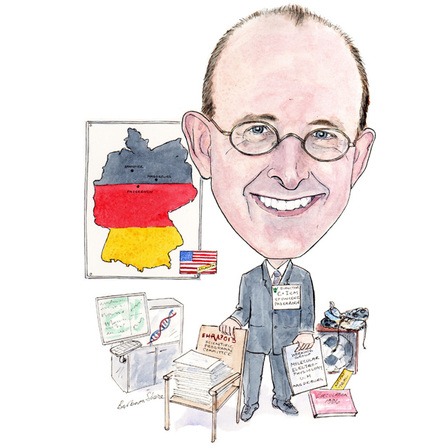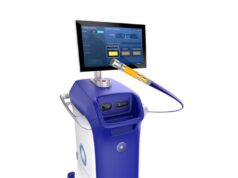
Andreas Goette, St Vincenz Hospital Paderborn and University Hospital Magdeburg, Germany, is the chair of the European Heart Rhythm Association (EHRA) Europace Scientific Programme Committee. He spoke to Cardiac Rhythm News about his research in molecular electrophysiology, a subject which was absent 15 years ago. He also gave his views on antiarrhytmic drugs and catheter ablation technology, and spoke about the highlights of EHRA Europace 2013
When did you decide you wanted a career in medicine?
Becoming a doctor was always my dream. I decided almost when I was still in elementary school.
Why did you decide to specialise in cardiology and electrophysiology?
I realised quite early in medical school that electrophysiology interested me and I took the final decision when I chose the topic of my medical thesis that recorded late potentials in patients who survived sudden cardiac death.
Who were your mentors and what influence did they have on your career?
My main mentor is Helmut U Klein. He is considered one of the pioneers in the field of cardiac defibrillation therapy. I used to work with him at the University Hospital Hannover, Germany, and later on for the following 15 years at the University Hospital Magdeburg, Germany.
Jonathan J Langberg (Atlanta, USA) introduced me into the field of basic research. I had the chance to work with him from 1994 to 1995 at Emory University in Atlanta.
You have been involved in various clinical trials. Which piece of research are you most proud of and why?
One main finding of my work is the description that cellular calcium-overload occurs in the initial phase of atrial fibrillation in atrial myocytes. This fundamental finding has stimulated many researchers for years. Our publication in Circulation in 1996 was one of the most cited papers at that time. Later, Prof Uwe Lendeckel from the University Hospital Magdeburg and myself were the first researchers to describe the impact of angiotensin II on structural remodeling on human atrial tissue in patients with and without atrial fibrillation.
These findings were the basis of the recently published ANTIPAF trial, which was a randomised, multicentre, double-blinded clinical trial, designed to proof the principle that angiotensin II receptor blockers have an antiarrhythmic potential.
What is your biggest motivation of working in medicine?
The motivation always comes from satisfied patients. They stimulate me to continue working long hours.
What have your proudest moments been?
When our results about electrical remodelling were accepted as one of the best cutting edge research results for the American College of Cardiology (ACC) meeting in 1996. This was a very prominent moment in my early career.
In your view, what has been the most important development in electrophysiology during your career?
The impact of molecular biology was almost absent 15 years ago. At present, the cellular mechanisms of arrhythmias are much more appreciated.
Of the research you have seen in the past year, which did you find the most interesting and why?
Several brilliant studies have been published on molecular biology of atrial tissue during the last years. It is extremely impressive to me how Stan Nattel from Montreal (Canada) contributed in this field. His group has published substantial papers, for example, on fibroblast morphology, molecular function and electrophysiology using in vitro and in vivo models. These results have made a significant impact in clinical electrophysiology. We were stimulated by his results to perform our own experiments in our laboratory at the University Hospital Magdeburg.
How far do you think it is possible to go with regard to advances to antiarrhythmic drugs?
It will be very difficult these days to find and approve an antiarrhythmic drug that has a strong antiarrhythmic action without substantial side effects.
In your opinion, what recent catheter ablation technology will have the greatest impact in the field?
The measurement of contact force is a big step in the right direction. In addition, the mapping of rotors during an electrophysiology study appears as a very promising for specified ablation attempt in patients with atrial fibrillation.
What could you tell us with regards to the latest advancements in molecular electrophysiology?
Molecular biology has helped to define novel potential drug targets. However, we need to analyse the molecular findings in individual patients. This has become clear from many of the latest papers. The results in molecular medicine may not help to support the strategy of “one size fits all”.
Being a member of the European Heart Rhythm Association (EHRA), in your opinion, what have been the greatest achievements of this association in the field?
The main achievement is that the European electrophysiologists have now a platform to interact during meetings such as the Europace congress. In addition, EHRA is now the leading association for education and training in electrophysiology. EHRA board exams have been adopted by the first European countries as a prerequisite to practice electrophysiology. Therefore, the impact of EHRA in the electrophysiology community is outstanding.
You are the chair of the Scientific Programme Committee of EHRA Europace 2013, could you tell us what the highlights of this year’s meeting are?
This meeting has received the largest number of abstracts ever. The abstracts were submitted from all parts of the world showing that EHRA and Europace are recognised and accepted as one of the important electrophysiology meetings in the world. Europace has integrated the annual meetings of the working group of e-Cardiology and of the working group of cardiac cellular electrophysiology into the programme.
Furthermore, we will have the presentation of late breaking trials during the meeting. Due to the very high number of submissions, we had to dedicate two separate sessions to this cutting edge research. In addition, the new guidelines on cardiac pacing will be presented for the very first time.
Could you tell us about one of your most memorable clinical cases?
The first successful ablation of a slow pathway, which I performed in the first year of my internship. This was very unusual since ablations procedures are typically done by fellows. This shows that Prof Helmut Klein, who was head of Department during that time at the University Hospital Magdeburg, strongly supported me from the very beginning throughout my career.
What are your current areas of research?
The main focus of my research is on molecular mechanisms and molecular biology of atrial fibrillation. We have published several basic science papers in this field as well as results of clinical investigations and trials.
Outside of medicine, what other hobbies or interests do you have?
My main hobby, at this point, is my family with my three kids. Since the oldest is just nine years old they require much of my spare time. Otherwise, I like football a lot, which I used to play quite heavily for many years.
Fact file
Education
1987–1994 Medicine studies, Medizinische Hochschule Hannover (MHH), Germany
1990–1994 Doctoral Thesis, Medizinische Hochschule Hannover, Germany (summa cum laude)
1994–2002 Residency / Fellow at Division of Cardiology, University Hospital Magdeburg, Germany
1995–1996 Postdoctoral Research Fellow, Department of Electrophysiology, Emory University Hospital, Atlanta, USA
2002 Board certification in Internal Medicine, University Hospital Magdeburg, Germany
2003 Venia legendi in Internal Medicine
2004 Board certification in Cardiology, University Hospital Magdeburg, Germany
2005 Board Certification in Intensive Care Medicine, University Hospital Magdeburg, Germany
Professional career
1995–1996 Postdoctoral Research Fellow, Department of Electrophysiology, Emory University Hospital, Atlanta, USA (Jonathan J Langberg)
1994– Division of Cardiology, University Hospital Magdeburg, Germany
1998– Head of Research Group on Molecular Cardiology and Electrophysiology
2000 Research Fellowship: “In vitro differentiation of pluripotent stem cells”; Emory University Hospital, Atlanta, USA (Samuel Dudley)
2002 “Oberarzt” at Division of Cardiology, University Hospital Magdeburg, Germany
2003 Venia legendi in Internal Medicine; Member of the Medical Faculty (University Magdeburg, Germany)
2005–2008 Head of Intensive Care Unit, Department of Internal Medicine, University Hospital Magdeburg, Germany
2006–2009 Deputy chief of the Division of Cardiology, University Hospital Magdeburg, Germany
2010– Director of Cardiology and Intensive Care Medicine St Vincenz Hospital Paderborn, Germany Head of Working Group “Molecular Electrophysiology” University Hospital Magdeburg, Germany, Chair of the Scientific Programme Committee European Heart Rhythm Association (EHRA)
Awards
Oskar Lapp Award 1996, founded by the German Cardiac Society
Bruno Kisch Award 1997, founded by the German Cardiac Society
HEXAL Research Award 2000









